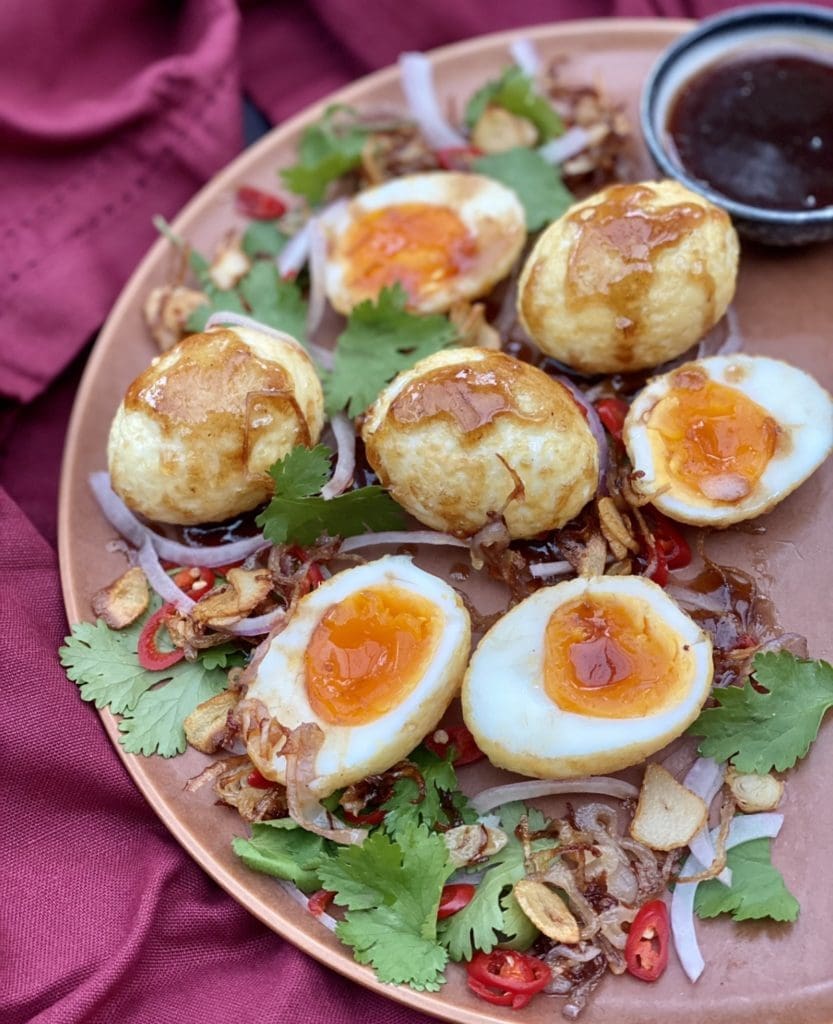
Fall in love with this unique and delicious Thai ‘Son-in-law Eggs’ dish, it has the perfect balance of sweet, sour, spicy and savoury flavours
Hello deep fried eggs!
It’s all about being health conscious these days, that’s why the health and weight loss industry is raking in millions of dollars. We’re well aware of the good, the bad, and the ugly food available. Deep-fried foods may lean towards the ugly side of the food chain! BUT, can we say that home fried food is healthier?
I’m going with yes it is! Frying at home means we can choose the type of oil to use and we know how clean the oil is. We also have full control of the ingredients in our veggies or proteins that we plan to fry, which means there’s no nasty artificial stuff or cheap fillers added to our food.
Now that’s sorted, it’s time to boil some eggs and fry them whole!
These Thai inspired Son-in-law eggs take deep frying to a whole new level! We’re frying eschalots, garlic, and medium-boiled eggs in their entirety. Then we’re going to drizzle them with a super delicious sweet and sour tamarind sauce. Eating deep-fried food has never been so much fun and creative!


These fried eggs are so golden and delicious that it would make Jack envious. Remember Jack? He’s that evil kid that grew a beanstalk, climbed it, steals a goose that laid golden eggs from a giant, then kills him. Oh, how I loved children’s bedtime stories back then! If Jack tried to steal Son-in-law eggs off me, you can bet that he’ll come out second best!
Like most Thai dishes, Son-in-law eggs have so much flavour happening! It’s salty, sweet, savoury and fresh with plenty of textures. The fried eggs have a chewy exterior with creamy insides that complement the tamarind sauce wonderfully. It’s a unique tasty dish that is definitely worth trying!

For the latest recipes, join our FREE 3CatsFoodie mailing list
What the heck are Son-in-law eggs?
Good question. I also asked myself this when I saw it years ago on the menu and had to order it out of curiosity. I was dining at a local Thai restaurant a few suburbs away from me with Olga, my very extroverted friend.
As soon as Olga heard me order Son-in-law eggs, she lost the plot. “Did you just say Son-in-law eggs?” I nodded. “OMG, that’s hilarious! Why is it called Son-in-law eggs?!” I shrugged, so she turned to the waitress and asked if she knew why. The waitress also answered Olga with a shrug.
“Olga, order your food!” I said, hoping to calm her down, pointing to the menu, but I was too late. She was already interrupting some diners next to us.
“Hey, what are Son-in-law eggs? do you know the story behind it?” Luckily, the diners were really sweet and happy to engage in banter with Olga.

“I seriously can’t take you anywhere!” I said, rolling my eyes after she placed her order. Olga laughed and told me to relax. She was busy on her phone, Google searching for the meaning behind ‘Son-in-law eggs’. Olga let out a loud squeal of laugher and read out what she found, but I only remembered these two:
- Thai mothers made fried eggs for their son-in-laws as a veiled threat that if they don’t treat their daughter right, they would fry their… um…yeah… you know what I mean.
2. The sons cooked fried eggs for their mothers-in-law when they visited because it was the only dish they knew how to make.
Hmm, I’m going to go with number 1 as it’s more memorable. However, what was more memorable was the actual dish. I fell in love with Son-in-law eggs that day!
A Thai dish definitely worth trying
Although it’s not too difficult to make Son-in-law eggs, there are a few steps involved.
One massive shortcut that would save time when making this dish is using prepackaged fried eschalot and garlic. Unfortunately for us, we’re currently in lockdown, so I can’t travel over 10 kilometres from our house. No Asian grocery store near us sold this, so I fried the eschalot and garlic.
Son-in-law eggs are cooked twice. It’s first boiled to medium, then it sits in an ice-water bath. This makes the eggs easier to peel and helps prevent them from being overcooked when fried. The eggs should still be medium-boiled after frying.

Making this for the first time is finicky, to be honest, but it gets easier after a few attempts. The tamarind sauce is easy to make because everything gets thrown in a pan.
I’ve made these Son-in-law eggs many times as our family loves them. It’s a convenient dish to make when we have no meat in the fridge. You can make this dish spicy by adding fresh red chillies in the sauce or over the top of the eggs before serving. Son-in-law eggs are in the entrée (appetiser) section of the menu, but I love making a big batch and serving it with hot steamed Jasmine rice as a main dish.
Ingredients for Son In Law Eggs

Eggs – I used large free-range eggs weighing approximately 58gm (2oz) each or 700gm (25oz) for a dozen. Son-in-law eggs are usually medium-boiled before frying, the egg whites are firm and the yolks are semi-firm.
Lemongrass – Cut 2cm off from the base of the lemongrass and keep 10-15cm of the stalk and cut off the remaining. Peel off 2 to 3 layers off, then cut the lemongrass in half. Smash the lemongrass a few times using a heavy object like a rolling pin. This will help the lemongrass release its flavours whilst cooking.
Fried garlic and eschalot – Asian grocery stores sell prepackaged fried garlic and eschalot (shallots). For convenience, I would’ve purchased some. Some restaurants also used prepackaged ones. I wasn’t able to get any because we’re under lockdown, so I fried my own. Eschalots look like small brown onions but are skinny and oval-shaped, they’re difficult to peel and way more expensive than other types of onions.
Palm sugar is a sweetener derived from the saps of palm trees and has a beautiful caramel flavour. It’s sold in supermarkets and Asian grocery shops. Make sure it’s 100% pure palm sugar, as some brands combine palm sugar with regular sugar. Brown sugar is a suitable substitute for palm sugar, just use the same amount required.
Fish sauce – My favourite brand is ‘Squid’ fish sauce from Thailand, but any brand of fish sauce will work. It’s sold at supermarkets in the International section or at Asian grocery stores.
Tamarind paste (tamarind concentrate or puree) is what makes this dish sour. You can find this tamarind paste in the international section in supermarkets or at Asian grocery stores.
How to make Son In Law Eggs
Step-by-step guide with photos


Frying eschalot (shallot) and garlic – Slice the garlic and eschalot thinly. Deep fry separately on medium to high heat for one or two minutes or until golden, stirring occasionally. Don’t let the garlic burn, otherwise, it’ll taste bitter. Remove any excess oil by gently pressing the garlic and eschalot with paper towels. Set aside.
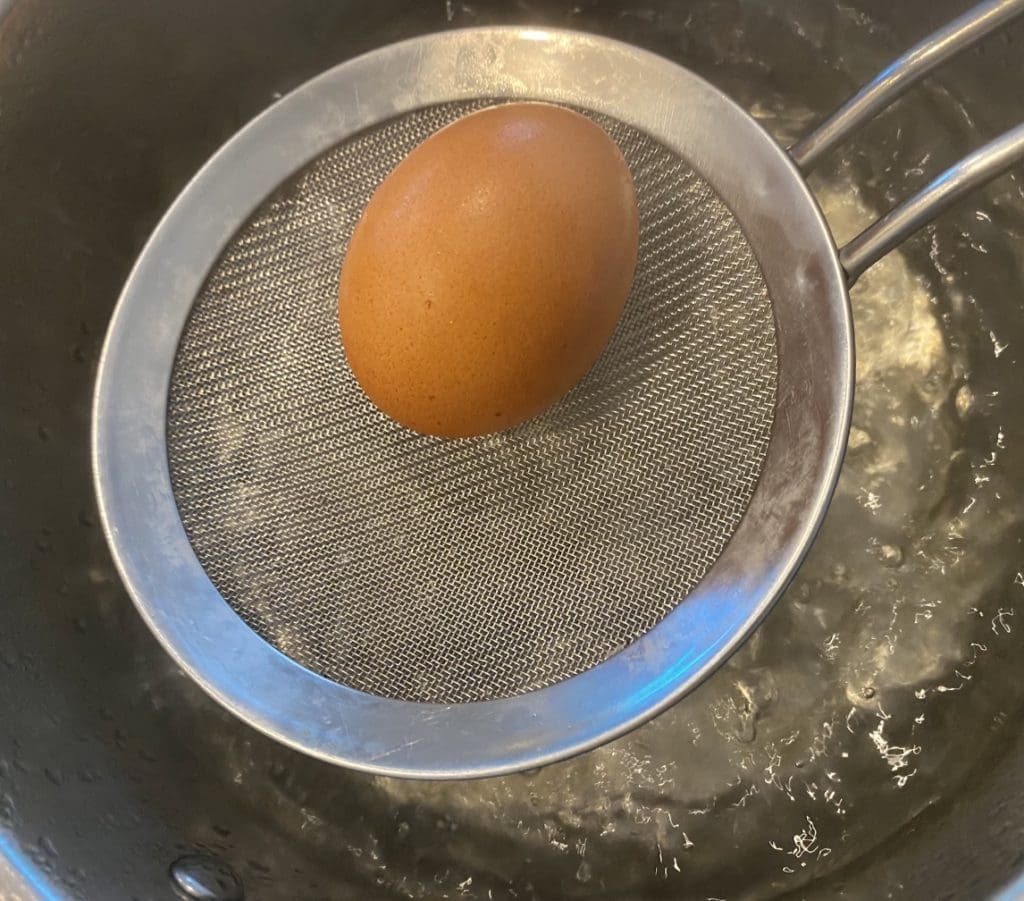
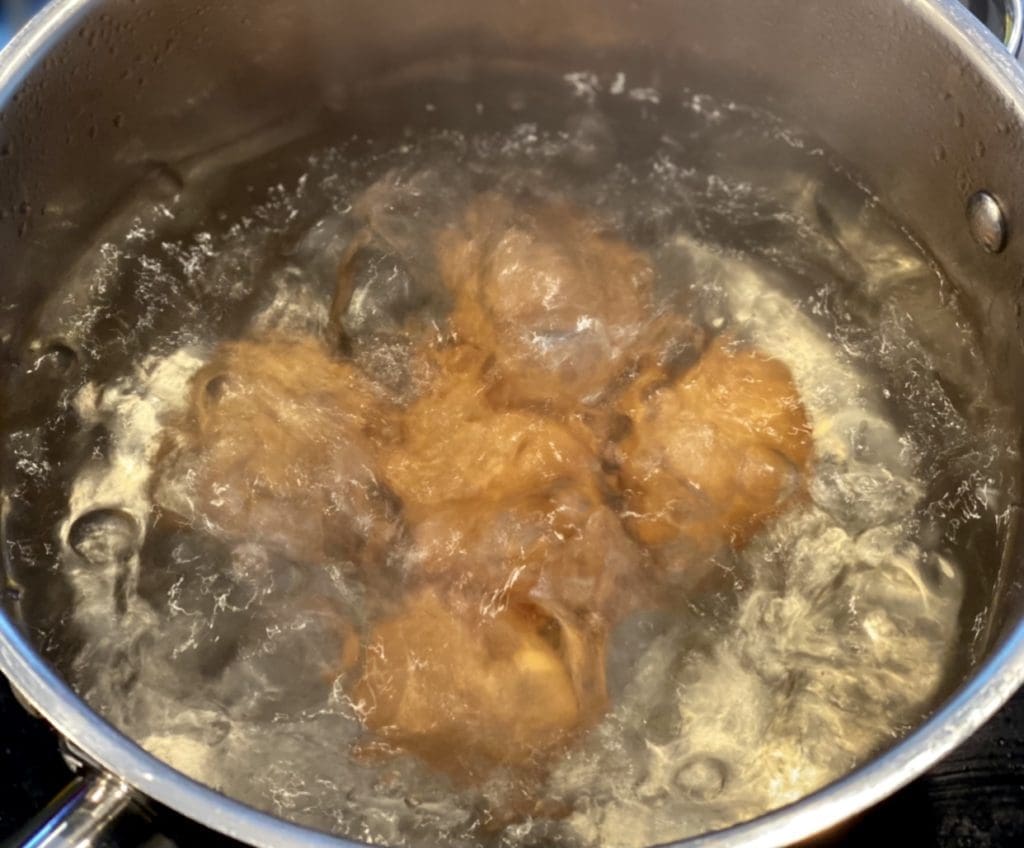

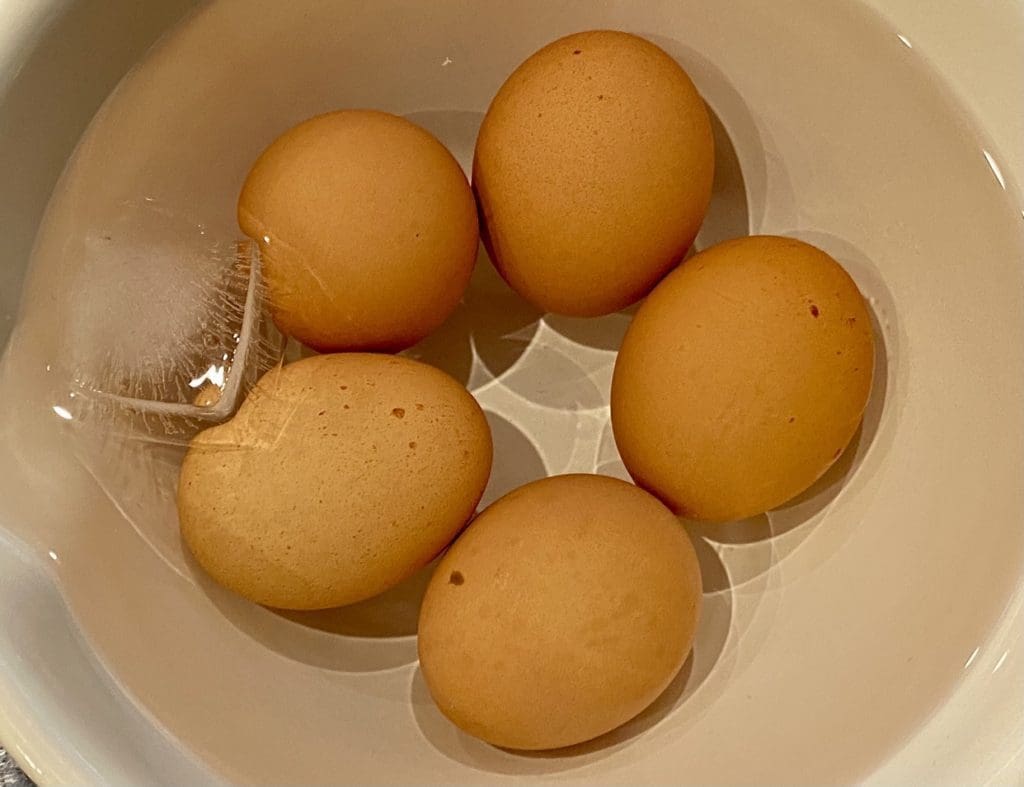
Pour enough water in a saucepan to submerge the eggs by at least one inch. Bring the water to a boil over medium to high heat, then carefully lower the eggs into the water. Room temperature eggs take 5 minutes and refrigerated eggs take 8 minutes to boil for medium cooked eggs. Prepare an ice bath for the eggs by placing water and ice into a bowl. Place the eggs immediately into the ice bath once they’re done. Set aside.
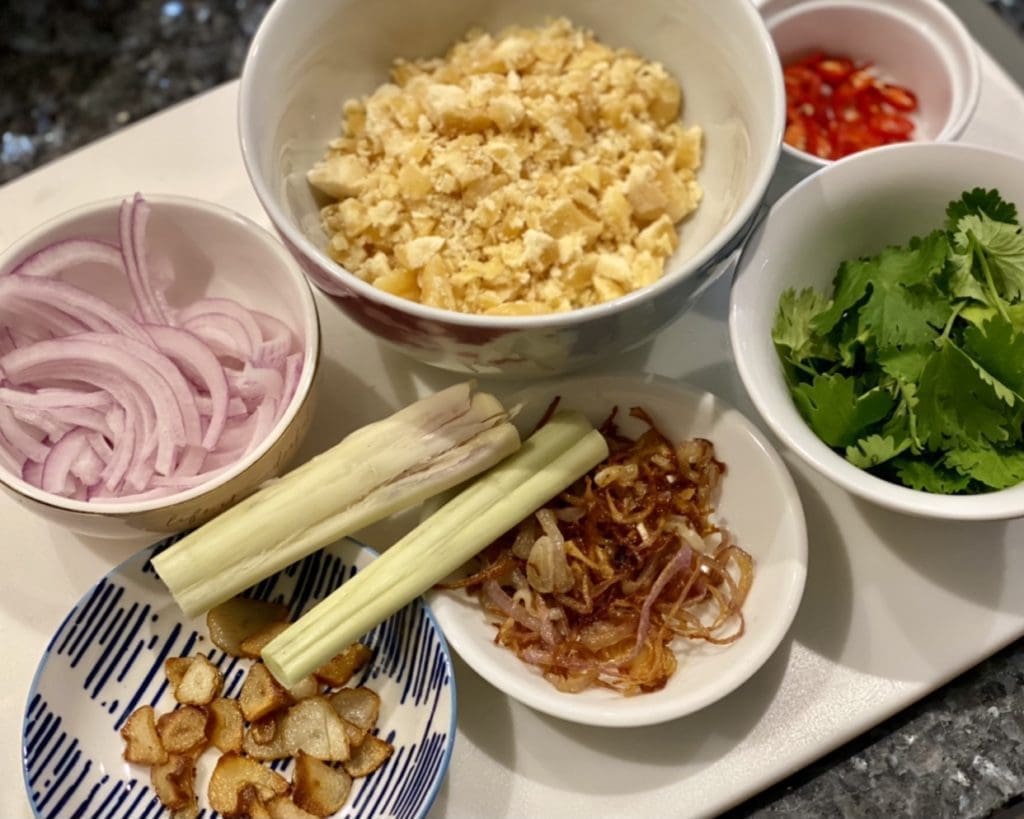
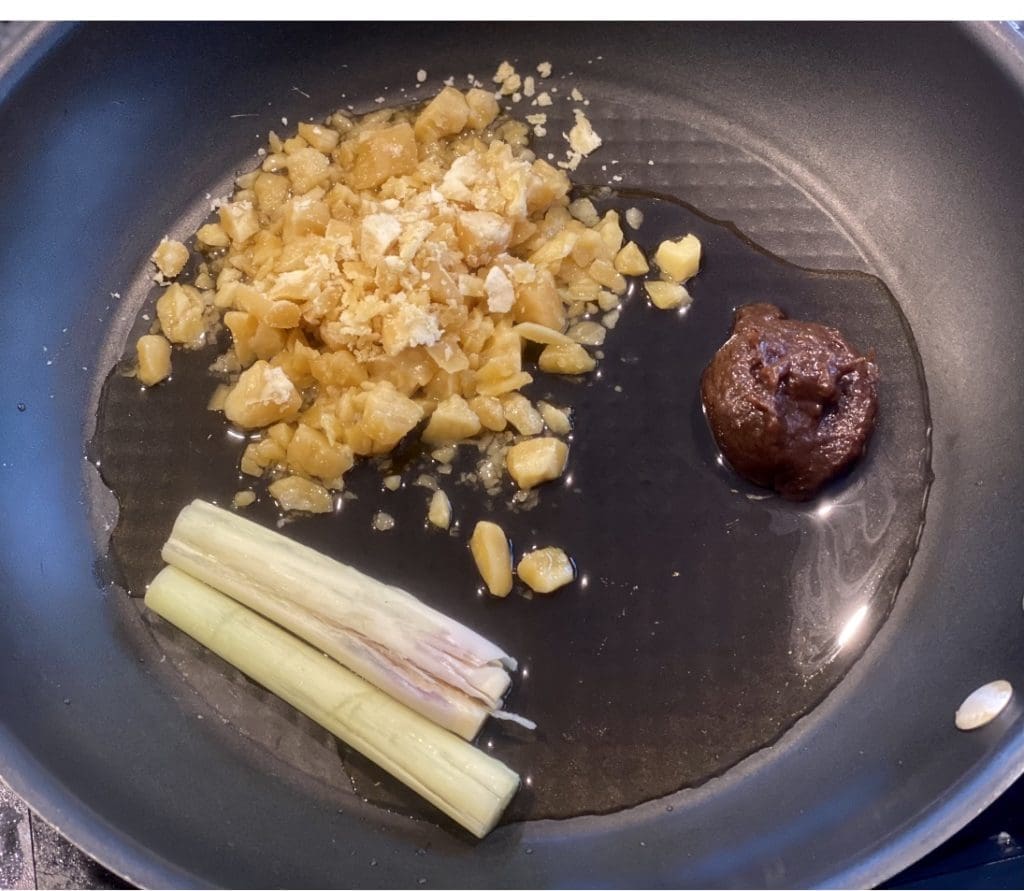


Place palm sugar, lemongrass, tamarind, fish sauce and water into a frying pan. Stir to cook over medium to high heat until the sugar dissolves, and the mixture bubbles. Reduce the heat and allow to simmer for 2 to 3 minutes or until the sauce thickens. Remove pan from heat but keep the sauce in the pan to reheat up for later.
Fry the eggs
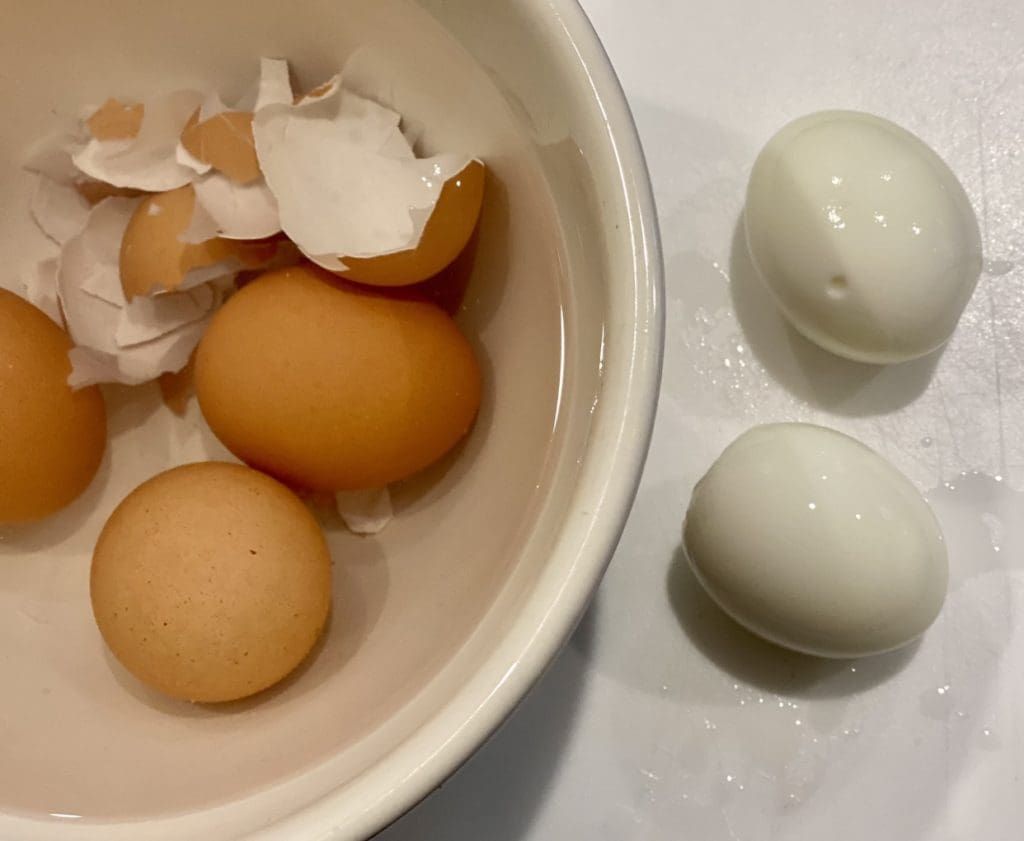
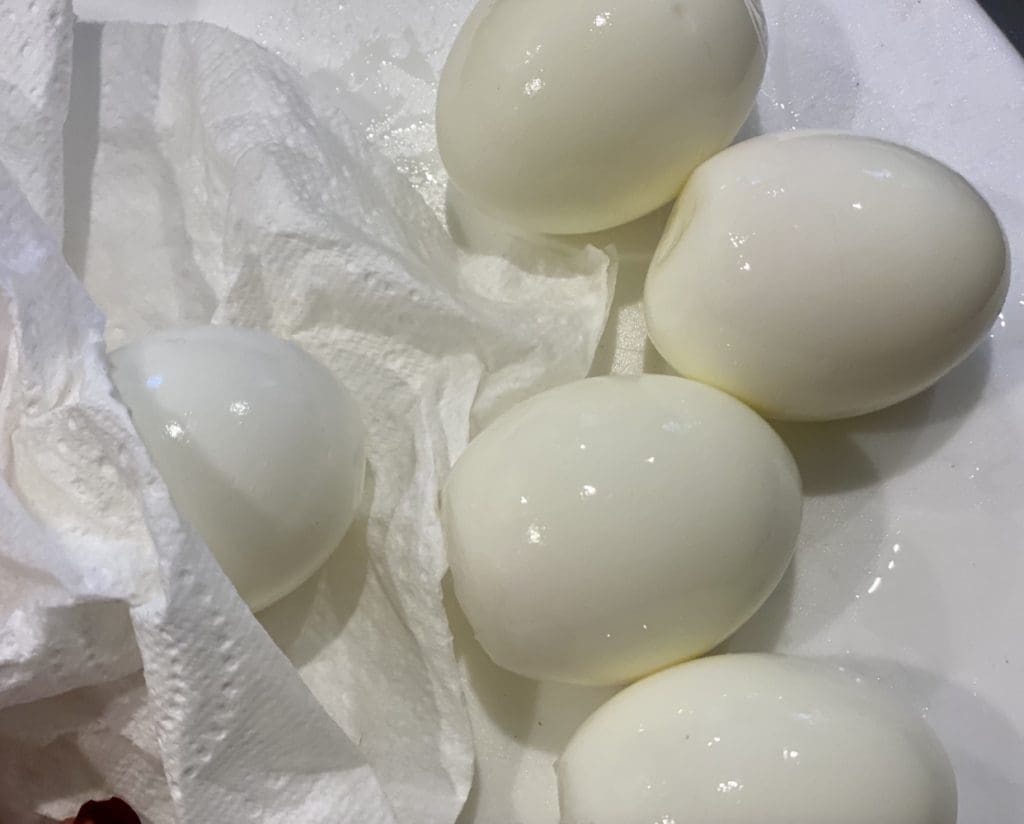


Peel the eggs and pat them dry with paper towels. If there is any water left on the eggs, it’ll cause the oil to splatter. In a wok or saucepan, pour enough oil to cover eggs, place over medium to high heat. Heat the oil to 170°C (340°F) or test the oil by placing a wooden object into the oil (chopstick, skewer or wooden spoon). The oil is ready for frying if it bubbles around the wooden object. Fry the eggs for 4 minutes or until golden, gently turn the eggs so it cooks evenly. Allow the eggs to rest for a few minutes before slicing them in half. Place the eggs on a serving plate.



Reheat the sauce in the frying pan over medium heat until it is bubbles. If the sauce is too thick, thin it out by adding little splashes of water. It should have the consistency of syrup. Spoon the sauce over eggs and top it with chilli, onion, coriander, fried shallots and garlic. Serve the eggs with rice.
Leftovers – Allow the eggs to cool completely at room temperature. Transfer the eggs into a sealed container and refrigerate, it’ll be good for up to 3 days.
Looking for more Asian dishes? try Japanese Karaage Fried Chicken or the quick and tasty Homemade Pho
Cooking measurements are in Australian standard spoon and cup measurements.
A Third-Party Application calculated the calories and nutritional information. Please use this as an approximate guide only.
I would love to hear your thoughts or feedback on this post. If you have made this recipe, please show your support by commenting and rate this recipe. You can do this by scrolling down or by clicking the green circle on the left. To prevent spam on this site, your email address is required but it will not be published.
Cheers (I’ll drink to that) – Cat Tre

Son In Law Eggs
Ingredients
- 5 large eggs (NOTE 1)
- Vegetable oil to fry
For the sauce
- 120 gm palm sugar (chopped roughly into small pieces) (NOTE 2)
- 1 lemongrass (chopped in half and bruised) (NOTE 3)
- 1 tbsp tamarind concentrate (NOTE 4)
- 2 tbsp fish sauce (NOTE 5)
- 3 tbsp water
For the topping
- 1 small eschalot (or 1 tbsp fried shallots) (NOTE 6)
- 3 cloves garlic (or 1 tbsp fried garlic) (NOTE 6)
- 2 Thai red chillies (or any small red chillies, sliced thinly)
- ½ cup coriander leaves (cilantro)
- ¼ red onion (sliced thinly)
Instructions
- Frying eschalot (shallot) and garlic – Slice the garlic and eschalot thinly. Deep fry separately on medium to high heat for one or two minutes or until golden, stirring occasionally. Don't let the garlic burn, otherwise, it'll taste bitter. Remove any excess oil by gently pressing the garlic and eschalot with paper towels. Set aside.

- Pour enough water in a saucepan to submerge the eggs by at least one inch. Bring the water to a boil over medium to high heat, then carefully lower the eggs into the water. Room temperature eggs take 5 minutes and refrigerated eggs take 8 minutes to boil for medium cooked eggs. Prepare an ice bath for the eggs by placing water and ice into a bowl. Place the eggs immediately into the ice bath once they're done. Set aside.

- Place palm sugar, lemongrass, tamarind, fish sauce and water into a frying pan. Stir to cook over medium to high heat until the sugar dissolves, and the mixture bubbles. Reduce the heat and allow to simmer for 2 to 3 minutes or until the sauce thickens. Remove pan from heat but keep the sauce in the pan to reheat up for later.

- Peel the eggs and pat them dry with paper towels. If there is any water left on the eggs, it'll cause the oil to splatter. In a wok or saucepan, pour enough oil to cover eggs, place over medium to high heat. Heat the oil to 170°C (340°F) or test the oil by placing a wooden object into the oil (chopstick, skewer or wooden spoon). The oil is ready for frying if it bubbles around the wooden object. Fry the eggs for 4 minutes or until golden, gently turn the eggs so it cooks evenly. Allow the eggs to rest for a few minutes before slicing them in half. Place the eggs on a serving plate.

- Reheat the sauce in the frying pan over medium heat until it is bubbles. If the sauce is too thick, thin it out by adding little splashes of water. It should have the consistency of syrup. Spoon the sauce over eggs and top it with chilli, onion, coriander, fried shallots and garlic. Serve the eggs with rice.








